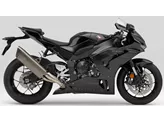Yamaha R1 2015 vs. Kawasaki Ninja ZX-10R 2016

Yamaha R1 2015

Kawasaki Ninja ZX-10R 2016
Vue d’ensemble - Yamaha R1 2015 vs Kawasaki Ninja ZX-10R 2016
The Yamaha R1 model year 2015 and the Kawasaki Ninja ZX-10R model year 2016 are both high-performance supersport motorcycles with similar technical specifications. However, there are some notable differences between the two.
In terms of engine and drive train, both motorcycles have a 998cc engine with four cylinders. The Yamaha R1 has a bore of 79mm and a stroke of 50.9mm, while the Kawasaki Ninja ZX-10R has a slightly smaller bore of 76mm and a larger stroke of 55mm. Both bikes have a compression ratio of 13, but the Yamaha R1 produces 200 horsepower and 112.4 Nm of torque, while the Kawasaki Ninja ZX-10R produces 200.1 horsepower and 114.3 Nm of torque.
In terms of suspension, both motorcycles feature upside-down telescopic forks at the front. The chassis of both bikes is made of aluminum, which provides a lightweight yet sturdy frame. Both motorcycles also have double disk brakes at the front, which offer excellent stopping power.

Yamaha R1 2015
In terms of dimensions and weights, both motorcycles have a front tire width of 120mm and a rear tire width of 190mm. The front and rear tire diameters are also the same at 17 inches. The Yamaha R1 has a wheelbase of 1405mm, while the Kawasaki Ninja ZX-10R has a slightly longer wheelbase of 1415mm. The seat height of the Yamaha R1 is 855mm, while the Kawasaki Ninja ZX-10R has a lower seat height of 813mm. Both motorcycles have a fuel tank capacity of 17 liters.
Now, let's move on to the strengths and weaknesses of each motorcycle. The Yamaha R1 2015 is known for its crazy sound and rev-happy engine with a strong peak. It provides a great racing feeling in the saddle and has a superior electronics package. The high-quality workmanship of the Yamaha R1 is also worth mentioning.
On the other hand, the Kawasaki Ninja ZX-10R 2016 has a great chassis geometry and high-quality chassis components. It also boasts very good brakes and has a wide range of electronics on board.

Kawasaki Ninja ZX-10R 2016
However, the Yamaha R1 2015 does have some weaknesses. It experiences torque sag in the middle, which can affect its performance. Additionally, stability in the braking zone may be a concern for some riders.
Similarly, the Kawasaki Ninja ZX-10R 2016 has a weakness in terms of cockpit readability. The cockpit may not be optimal for easy reading while riding.
In conclusion, both the Yamaha R1 2015 and the Kawasaki Ninja ZX-10R 2016 are powerful and capable supersport motorcycles. They have similar technical specifications but differ in terms of strengths and weaknesses. Ultimately, the choice between the two will depend on the rider's preferences and priorities.
Caractéristiques techniques Yamaha R1 2015 par rapport à Kawasaki Ninja ZX-10R 2016
Avantages et inconvénients en comparaison
Avantages et inconvénients en comparaison
Yamaha R1 2015

La nouvelle R1 est une grande réussite et n'a plus rien à voir avec le modèle précédent. Celle-ci était considérée comme une bonne moto de campagne et il fallait investir lourdement pour les excursions sur les pistes de course. Aujourd'hui, c'est l'inverse. La nouvelle R1 a été développée en mettant clairement l'accent sur les pistes de course. Le package électronique semble exceptionnel, les technophiles y trouveront leur compte. Les fans de Yamaha ne peuvent que sauter sur l'occasion, ils ont enfin une moto digne de ce nom. La R1 présente de légères faiblesses au freinage sur piste, où elle devient un peu instable. Ceux qui aiment acheter une moto de course prête à l'emploi, sans devoir travailler sur le châssis, ont intérêt à choisir la R1M. La suspension électronique d'Öhlins fonctionne à merveille et ne présente aucune faiblesse. Pour une utilisation purement sur circuit, il est également facile de corriger la deuxième faiblesse de la R1. Le trou de couple au milieu peut être facilement comblé par une nouvelle cartographie.
Kawasaki Ninja ZX-10R 2016

La ZX-10R Ninja a une certaine majesté, lors du premier roulage elle semble très stable, il faut la forcer un peu dans le rayon. Mais après quelques tours, cet effet se transforme en une incroyable précision qui permet de suivre une ligne bien ciblée. Le moteur est maintenant vraiment devenu sensiblement plus puissant et fait de la Kawa un énorme paquet global qui ne peut pas seulement plaire aux fans inconditionnels de Kawasaki. Le contrôle de traction se distingue de manière particulièrement positive sur la Kawa, il régule de manière très sensible. On peut même régler le frein moteur - elle ne manque donc certainement pas de fonctionnalités électroniques. La ZX-10R est la seule Superbike à être compatible avec la norme Euro4 dès 2016 !
Comparaison des prix Prix moyen du marché Yamaha R1 vs Kawasaki Ninja ZX-10R
There are a few key differences between a Yamaha R1 2015 and a Kawasaki Ninja ZX-10R 2016. It takes less time to sell a Yamaha R1 with 76 days compared to 100 days for a Kawasaki Ninja ZX-10R. Since model year 2005 1000PS.de editors have written 80 reviews for the Yamaha R1 and 51 reviews for the Kawasaki Ninja ZX-10R since model year 2005. The first review for the Yamaha R1 was published on 4/28/2003 and now has more than 3,900 views. This compares to more than 2,900 views for the first review on Kawasaki Ninja ZX-10R published on 1/11/2004.






















